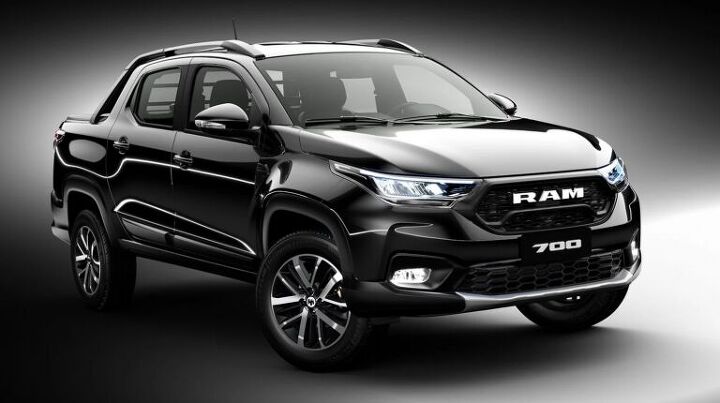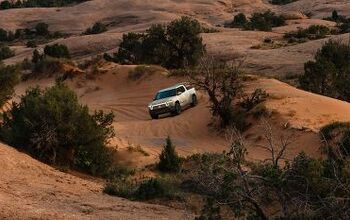Could the Ram 700 Foreshadow Something Smaller for North America?

Americans love their pickups but the segment’s sizing has adopted the same methodologies favored by the McNugget industry. Medium-sized trucks are now supersized, leaving full-sized pickups in danger of developing their own gravitational fields. However, it wasn’t all that long ago when the North American market was awash with compact pickups like the original Ford Ranger, Chevrolet S-10, and numerous Japanese alternatives — including the legendary Toyota Hilux (which we just called “the Pickup”). Dodge even had the Dakota for customers who liked D.I.Y. projects but wanted something a little larger and more capable of hauling the necessary materials in a single trip.
Back then, the competition was incredibly fierce. But club cabs gradually evolved into crew cabs and, before anybody knew what happened, every single pickup left on the market had become monstrously large. Though it wasn’t like that everywhere in the world. Plenty of markets still appreciate the handyman’s pickup and Latin America is about to receive an updated one from Fiat Chrysler Automobiles. It’s called the 2021 Ram 700 and serves as the spiritual successor of the Ram 50/Mitsubishi Mighty Maxx.
While Jeep’s Gladiator does battle on what remains of the midsize pickup segment until the real Dakota returns, the Ram 700 carries on Chrysler’s legacy of badge engineered micro trucks. It’s based on the (updated for 2020) Fiat Strada and looks decidedly better in its new duds.
On Wednesday, the automaker revealed the 700 for 14 Latin American markets (including Mexico). While FCA expanding its availability south of the border means little for us right now, rumors have been swirling that Ram has been considering getting a small truck onto the North American market for some time. That may end with the assumed 2022 Ram Dakota being slotted in as a middleweight. But the compact pickup segment is basically wide open and ready to serve the automaker that gets there first.
The Ram 700 would likely need to undergo a few changes were it to be exported here from Brazil, however. Most trims utilize a 1.4-liter inline-four engine that makes a rather sad 84 horsepower and 87 pound-feet of torque. But a 1.3-liter turbo (98 hp/94 lb-ft) is available on the Laramie trim, though it’s likewise front-wheel drive and comes standard with a manual transmission.
None of those should be deal-breakers for someone seeking a budget-conscious work vehicle designed to be used and abused for small-to-medium duty projects. Payloads of “up to” 1,600 lbs are more than enough to haul some lumber, auto parts, or that new dishwasher. But we know some people will be looking at those specs and decide nothing less than 290 hp with 3,000 lbs of payload will suffice — thus forcing themselves into a full-sized truck.
Of course, anyone interested in towing something larger than a bunch of balloons probably should consider the upgrade. The Ram 700 can only pull about 900 pounds of mass behind itself.
That taken into account, our only serious concern is the size of the bed. While Ram automatically provides the bedliner, it has decided to make all upper-level trims crew cabs by default. That leaves customers with 24.4 cubic feet of cargo volume, whereas the base cabin offers 40.3 cubic feet, and places them into an unwinnable decision. Do they halve their bed size to accommodate five passengers or stick or get the regular cab and hope they get more business than new friends?
[Images: FCA]

A staunch consumer advocate tracking industry trends and regulation. Before joining TTAC, Matt spent a decade working for marketing and research firms based in NYC. Clients included several of the world’s largest automakers, global tire brands, and aftermarket part suppliers. Dissatisfied with the corporate world and resentful of having to wear suits everyday, he pivoted to writing about cars. Since then, that man has become an ardent supporter of the right-to-repair movement, been interviewed on the auto industry by national radio broadcasts, driven more rental cars than anyone ever should, participated in amateur rallying events, and received the requisite minimum training as sanctioned by the SCCA. Handy with a wrench, Matt grew up surrounded by Detroit auto workers and managed to get a pizza delivery job before he was legally eligible. He later found himself driving box trucks through Manhattan, guaranteeing future sympathy for actual truckers. He continues to conduct research pertaining to the automotive sector as an independent contractor and has since moved back to his native Michigan, closer to where the cars are born. A contrarian, Matt claims to prefer understeer — stating that front and all-wheel drive vehicles cater best to his driving style.
More by Matt Posky
Latest Car Reviews
Read moreLatest Product Reviews
Read moreRecent Comments
- CoastieLenn I would do dirrrrrrty things for a pristine 95-96 Thunderbird SC.
- Whynotaztec Like any other lease offer it makes sense to compare it to a purchase and see where you end up. The math isn’t all that hard and sometimes a lease can make sense, sometimes it can’t. the tough part with EVs now is where is the residual or trade in value going to be in 3 years?
- Rick T. "If your driving conditions include near-freezing temps for a few months of the year, seek out a set of all-seasons. But if sunshine is frequent and the spectre of 60F weather strikes fear into the hearts of your neighbourhood, all-seasons could be a great choice." So all-seasons it is, apparently!
- 1995 SC Should anyone here get a wild hair and buy this I have the 500 dollar tool you need to bleed the rear brakes if you have to crack open the ABS. Given the state you will. I love these cars (obviously) but trust me, as an owner you will be miles ahead to shell out for one that was maintained. But properly sorted these things will devour highway miles and that 4.6 will run forever and should be way less of a diva than my blown 3.8 equipped one. (and forget the NA 3.8...140HP was no match for this car).As an aside, if you drive this you will instantly realize how ergonomically bad modern cars are.These wheels look like the 17's you could get on a Fox Body Cobra R. I've always had it in the back of my mind to get a set in the right bolt pattern so I could upgrade the brakes but I just don't want to mess up the ride. If that was too much to read, from someone intamately familiar with MN-12's, skip this one. The ground effects alone make it worth a pass. They are not esecially easy to work on either.
- Macca This one definitely brings back memories - my dad was a Ford-guy through the '80s and into the '90s, and my family had two MN12 vehicles, a '93 Thunderbird LX (maroon over gray) purchased for my mom around 1995 and an '89 Cougar LS (white over red velour, digital dash) for my brother's second car acquired a year or so later. The Essex V6's 140 hp was wholly inadequate for the ~3,600 lb car, but the look of the T-Bird seemed fairly exotic at the time in a small Midwest town. This was of course pre-modern internet days and we had no idea of the Essex head gasket woes held in store for both cars.The first to grenade was my bro's Cougar, circa 1997. My dad found a crate 3.8L and a local mechanic replaced it - though the new engine never felt quite right (rough idle). I remember expecting something miraculous from the new engine and then realizing that it was substandard even when new. Shortly thereafter my dad replaced the Thunderbird for my mom and took the Cougar for a new highway commute, giving my brother the Thunderbird. Not long after, the T-Bird's 3.8L V6 also suffered from head gasket failure which spelled its demise again under my brother's ownership. The stately Cougar was sold to a family member and it suffered the same head gasket fate with about 60,000 miles on the new engine.Combine this with multiple first-gen Taurus transmission issues and a lemon '86 Aerostar and my dad's brand loyalty came to an end in the late '90s with his purchase of a fourth-gen Maxima. I saw a mid-90s Thunderbird the other day for the first time in ages and it's still a fairly handsome design. Shame the mechanicals were such a letdown.






































Comments
Join the conversation
The answer is NO. The Strada/Ram 700 will never get to the US, not on its current form, which is nothing more than a tarted-up poormobile. The next-gen Toro in another hand would be great for you guys.
Nobody has played in this section of the market (here in the US) for a long time. I believe there is demand for this "trucklet utility image" at a bargain price point. After a few model years, it can creep upmarket in price/features/power...just like every other car.